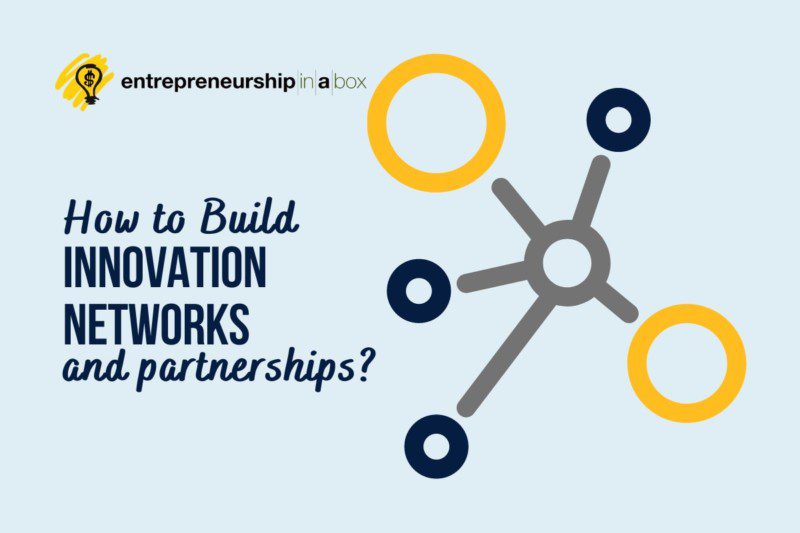Building partnerships and innovation networks are essential to success in business, especially if you want to innovate new products, services, processes, and business models. By jointly working through more efficient innovation networks and partnerships, you can build upon the strengths of other people and entities.
What’s the best way to get a new product on the market? Through innovation. Innovation involves coming up with innovative ideas, analyzing them, testing them, developing innovations, and then trying to get them accepted by other people.
When you don’t innovate, you become obsolete. Innovation is critical to any business, and the most prominent innovations today result from innovation networks where different people and companies work together to develop and bring innovation to the market.
We will discuss how you can use innovation networks to help your business innovate. In addition, we will offer steps for building an innovation network that will allow your organization to be more effective in the long run.
What is a Network?
We know that there is a high level of importance of networks for developing innovative companies and projects. But how can we make better use of these networks?
To answer this question, we must first know what a network is and how it is created and structured.
Let’s see what the network is.
A network is a complex interconnected group or system to accomplish a particular task.
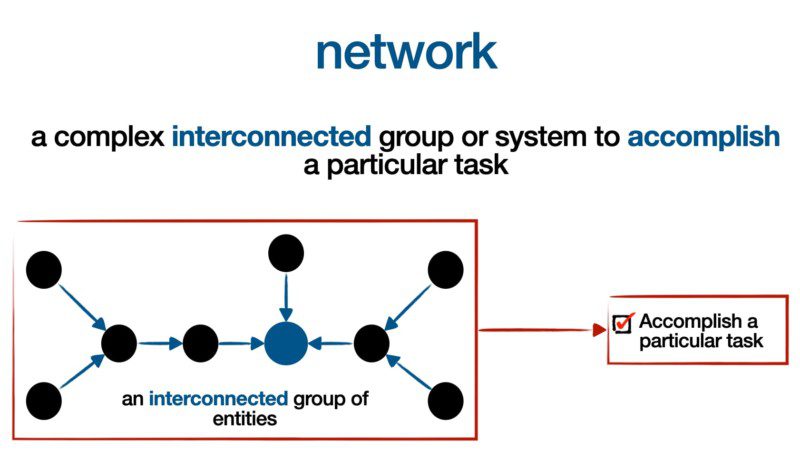
The first thing inside this definition is that we must have complex interconnected groups or systems. But, they are not inside the network because only to be part of the network. They are part of the network because they all want to achieve the same or similar goals and accomplish a particular task.
What is an innovation network?
An innovation network is a group of individuals and organizations exchanging information, knowledge, skills, and efforts to develop, introduce and sell innovative products on the market, improve their processes, or introduce a new business model.
Different companies, universities, government agencies, and other organizations can be part of the network. All of them will need to collaborate on research, development, or production of innovative products inside the innovation network. Innovation networks can also create alliances to transfer know-how or technology, developing and commercializing new ideas and concepts.
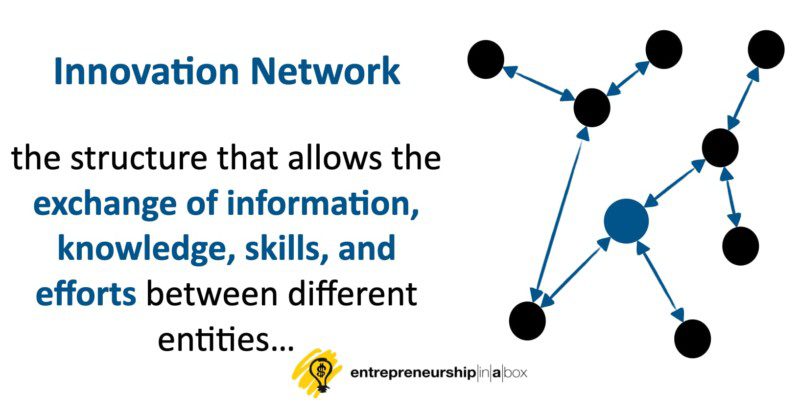
The network structure is a graph that includes nodes (persons or organizations) and links (relationships) between them. Each node represents an individual, company, entity, or member of the whole innovation network.
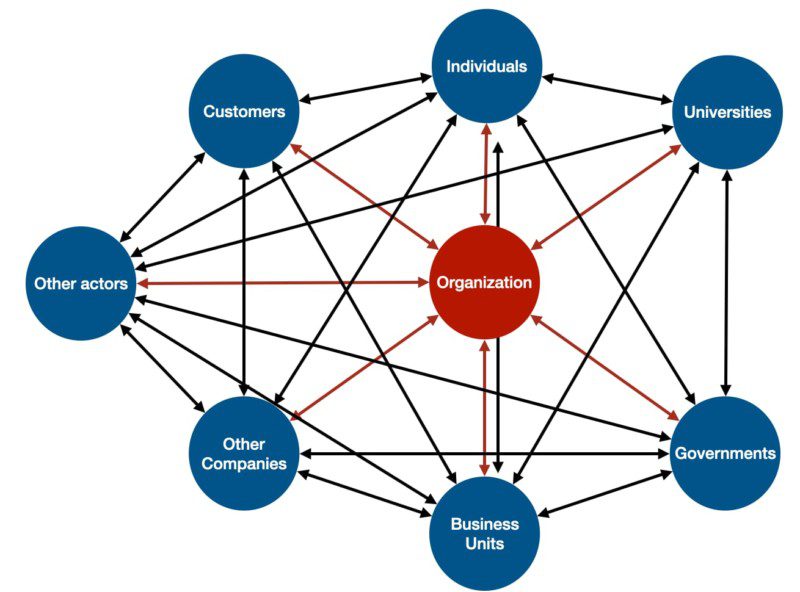
As you can see from the figure above, this innovation network is presented through one organization in the center that want to innovate something. But other entities inside the network can be government, universities, individuals, customers, business units, companies, and actors.
The best way to understand the innovation network is to include relationships between different actors. This is important because they will communicate and exchange ideas and experiences with other actors inside the network.
As you can see, an innovation network is a web of people and organizations connecting and collaborating on innovation projects, creating a rich ecosystem of knowledge and resources that benefits everyone involved.
It’s about collaboration, and it’s about sharing.
Why Do You Need Innovation Networks?
So why do we need innovation networks?
Here are some reasons why you will need an innovation network to bring innovation to the market efficiently.
1. Collective Efficiency
With innovation networks, companies can achieve collective efficiency, like access to different resources outside the company. It doesn’t matter if the company already has such resources or they don’t have them. It is essential to add value to current resources or use outside resources mixed with your resources to bring an innovative idea to become an innovative product, service, process, or business model.
For example, you must experiment with approving hypotheses and assumptions about new products and services.
You will have to conduct a lot of research and test your products and services in real life before they are released. Successful businesses must be able to adapt to change quickly and effectively. They cannot stay competitive in the long run if they cannot adapt to change. Suppose you don’t have the technology for experimenting. In that case, you need to find who has such technology and ask for help to jointly solve all innovation problems you will face throughout your innovation process.
2. Collective Learning
Another benefit is related to collective learning, like a shared learning process – new experiences or new skills. Innovation networks allow companies to share knowledge, resources, and best practices, which can help to reduce costs, improve efficiency, and accelerate innovation. All of this means increasing value for all participants inside the network.
You need to share insights from your research to get feedback and improve based on it quickly.
Many people and businesses don’t want to share what they know. But they don’t understand that today we live in sharing economy. Sharing economy brings synergy and better outcomes for everything you work on.
The sharing economy is a new concept that has become very popular recently. It is a concept where you share your stuff, skills, and knowledge with others who can benefit from them. This is a kind of peer-to-peer model that anyone can benefit from it.
It allows people to get more out of their time, resources, and money. It’s like giving back to the community. It will enable you to learn new things. Also, it helps to save money by avoiding expensive services. It is a win-win situation for both parties involved in sharing economy.
You must build a solid community of people or organizations who can quickly help you get the feedback you need. Again, you need an innovation network if you want your innovative products or services to succeed on the market.
3. Risk Sharing
The third significant benefit relates to risk sharing because of collective risk-taking. All of the participants inside the network invest something in the form of money, time, effort, or competencies. So, if they fail, it will not be a failure for one company but for the whole network.
4. Open Innovation
Some analysts argue that open innovation, or sharing ideas outside the company, can benefit companies.
Open-source software and peer-to-peer technology are examples of this.
Consider open-source software, typically developed by a large group of people contributing to it. The more people participating in open-source projects, the more likely they will add additional value. But, honestly, it can also bring conflicts between contributors. Such conflicts can sometimes lead to a totally innovative solution to the problem or development with too many problems.
Others see open innovation as threatening the company’s ability to control its intellectual property.
But, implementing solutions developed outside the company can reduce the time to market for a product, says Henry Chesbrough, who coined the keyphrase “Open Innovation,” a professor at the Haas School of Business at the University of California, Berkeley.
For companies with an existing product who want to quickly introduce new features or functionality, partnering with other companies is a great way to get this done.
It can also give the company access to new sources of innovation and competitive advantage. When you are developing a solution that is not in-house, you may need to partner with an outside firm to develop the solution. To determine if your company needs to hire or contract with outside help, ask yourself:
- Does the problem require an innovative approach?
- Do you have the expertise to develop the solution?
- Are you familiar with the necessary technologies to create the solution?
✋ Warning
What is the most significant difference between Kaizen and innovation?
Example of Innovation Networks
YouTube as an Innovative Product and the Required Network
Let’s go back in time and consider the stakeholders that have impacted the development of this innovative web-based service.
First, it was a startup like every other company started in 2005 by three former employees of PayPal. Their idea was that people wanted to share their homemade amateur videos. So, they have tested their idea as a beta version, attracting around thirty thousand visitors daily. Then, they decided to launch the official version of the service and quickly started to grow with visitors and the number of published videos.
At the same time, Google had launched its own video service called Google Video, but without success in attracting people, they decided to purchase YouTube for 1.65 billion.
So, what was required for the success of this service?
Own Competences
So, the first important thing for YouTube to become what it is today is based on its founder’s competencies and then Google’s employee’s competencies. They are the people who work on the code, maintenance of servers, and so on.
Technology Development
But I remember when we were limited to publishing long videos, only 10 minutes or less than X megabytes. This limited the potential growth of the service because of low-quality videos and a lower quantity of videos.
Why was this the case?
Technology development is a second factor that will impact innovative ideas.
At that time, we had slower processors and slower and limited servers. So, we were not limited by YouTube. We were limited by technology from that time.
Also, technology has limited the service because of low-quality cameras on, let’s say, smartphones at that time. Yes, we had digital cameras then, but it required connecting the camera to the computer saving the recording, editing the video, and then changing the format that would be acceptable for uploading on YouTube.
Today, we have phones with six to ten times better cameras, supported by software that improves the quality of recordings, and with the possibility of several taps on the phone to publish video on YouTube.
So, technology and the development of technology are essential for the success of innovation. And this is better done together with someone with higher expertise than working years alone to solve possible technological problems. This approves that innovation networks will bring shorter time to market for innovative products and services.
A similar example we have with Apple’s MacBook Air. This version of the laptop was the thinnest laptop at that time. But, to achieve this success, Apple was required to work with Intel to develop chips with higher capacity and lower dimensions. This is also additional approval of the importance of innovation networks.
Let’s go back to our case regarding YouTube. What is the next thing that requires networking for success?
Content Creators
The service’s success is based on visitors, but to have visitors, you need to have enough quality content in the form of videos.
With smartphones and different video recording equipment available to ordinary people, it becomes clear that everyone can upload their video on the platform. So, video creators are also an essential part of this whole ecosystem.
Also, Google negotiated deals with many companies from the entertainment industry, like TV networks, movie companies, and cable operators, to get copyrighted material.
Advertisers and users of the services
And lastly, but not less important, are advertisers and users of the services. Yes, YouTube requires advertisers who will pay when people click the advertising material or watch advertising material on the platform. Without them, innovation will not be possible.
Also, users or people who watch the content on youtube are essential because if they do not exist, there will not be advertisers.
Electric Vehicles
What are the stakeholders inside the innovation network/ecosystem for electric vehicles?
For many years we have tried to integrate this innovation developed more than a hundred years but without success. Today, we are seeing rapid progress towards more electric vehicles. But, still, traditional cars with an internal combustion engine is the leading car in use in many markets in the world.
So, what are the stakeholders inside the innovation ecosystem for electric cars?
Electric Vehicle Manufacturers
First, we will start again with the company that produces such a car. Their competencies in building practical electric cars are crucial to this innovation.
Supply Chain
Then we have the whole supply chain that will need to accept this innovative product and allow all required spare parts to be available in quantity required by manufacturers.
Battery Producers
The ecosystem’s third stakeholder will be the batteries manufacturers that will enable effective and efficient car movement. Again, here we will come to the development of the technology itself because the main challenge still being solved for this kind of product is enabling the car to drive longer with one battery charge. So, the quality of the electric vehicle will depend on the quality of the battery expressed capacity, the weight of the battery, and the price of the battery itself with such performances.
Charging Infrastructure
The fourth stakeholder of the ecosystem will be the battery charging infrastructure. The current infrastructure of gas stations allows carefree filling of the gas at a gas station at any distance you are driving the car without thinking about whether or not there will be a gas station. The customer of electric cars expects the same to be available.
Dealers
Dealers, who sell these vehicles, will represent the fifth stakeholder of this innovation ecosystem. If they don’t want electric cars in their offer, the innovation will not be exposed to potential customers.
Customers
And the sixth stakeholder will be the customers themselves or the users of this electric car. If they don’t want to buy such a car, they will not pay money that will be invested in new developments and innovations.
As you can see from these examples, these innovations require many stakeholders, simply members or partners inside the innovation ecosystem.
Many products have appeared on the market in recent years, like platforms connecting different sides inside one larger supply chain. For example, Amazon is a platform business that invests and innovates in infrastructure but then connects suppliers with end users. There are also many platforms for online training materials, like Udemy.
So, for many successful innovations today, responsibility is not only in one person or company but the network of different innovators inside the innovation network or ecosystem.
✋ Warning
Follow these steps to create an awesome business innovation process inside your company.
Internal and External Innovation Networks
Now we will continue with internal and external innovation networks. Remember that today’s innovation is a networking process.
It involves the exchange of ideas and information between different actors. The result is an innovation that becomes a part of daily life. Innovation is not the only outcome of networking. Networking can also provide opportunities to improve existing products and services.
There are two types of innovation networks, internal and external.
Both can help innovators overcome product/service development challenges, but they differ.
Internal Innovation Networks
An internal innovation network is a group of people, functions, sectors, or divisions that collaborates to solve problems. These networks are most often built around a specific problem. They’re focused on coming up with solutions.
Internal networks can be in two different forms.
- The first form is formal internal innovation networks that are formalized by participants inside the network with the precise definition of each participant’s roles, tasks, and benefits. This formalization comes from the organization, structure, processes, standard operating procedures, and manuals. So, we have formal or legal documents that create and manage formal networks inside an organization.
- The second type of network is an informal internal innovation network. Here we don’t have formalization. These networks are non-formal networks where participants participate at their own will. But, we need to consider that these networks are not bringing mandatory measures, but some of them will become mandatory. Each organization needs such networks because sharing ideas, talking about them, and building upon them can increase creativity and bring high-potential innovations.
External Innovation Networks
External innovation networks are created when companies or people from different companies collaborate to solve problems and provide better products and services to their customers. An external network of business partners who share similar goals and interests can often lead to new ideas and innovations that wouldn’t be possible without them. You can create an external innovation network by joining networks that are already in place or creating new ones.
Remember that external innovation happens when you exchange ideas with others outside your company. These innovation networks are more challenging to manage than internal ones.
✋ Warning
Here is how you can bring back innovation inside your small business.
How to ensure that people from different organizations collaborate?
How to ensure that people get to talk to others and build on each other’s ideas?
Have you seen a stock exchange for ideas? I have seen many entrepreneurs who make a mistake because they have not started in the early stage to share their thoughts about their ideas and build them on other people’s thoughts.
If you don’t share your thoughts with the world, the world will never be interested in your idea. The reason for this is that the world is full of people who are looking for an opportunity. The world is full of people who are interested in creating something new.
We must implement processes that standardize the need to talk with others and build on each other’s ideas.
Margaret Wheatley, for her first book in 1992, “Leadership and the New Science,” won many awards as the best management book. Also, she was one of the “Top Ten Business Books of the 1990s” and one of Xerox Corporation’s “Top Ten Business Books of all time.” She says:
“Innovation is fostered by information gathered from new connections, insights gained by journeys into other disciplines or places, active, collegial networks, and fluid, open boundaries. Innovation arises from ongoing circles of exchange, where information is not just accumulated or stored but created. Knowledge is generated again from connections that weren’t there before.”
Margaret Wheatley
So, connections and networking are among the most important things when discussing innovation. Why? It is important today to listen inside the organization and from everywhere, including the organization’s environment. We must listen and connect with other people and organizations worldwide to create new knowledge.
Connecting with others is important because it allows us to learn. We have a lot of books and materials that teach us how to innovate. But it is not enough to read all these materials to innovate. Understanding the best practices and how they work in practice is essential.
Types of Innovation Networks
Strategic Alliances
Let’s see what strategic alliances are.
They are two or more organizations that come together, formally or informally, temporarily or permanently, to share resources, knowledge, markets, staff, capital, and R&D to gain a competitive advantage or strategically plan for the future.
As you can see, whether these alliances are formal or informal, temporary or permanent, doesn’t matter. They must share resources, knowledge, markets, staff, capital, and R&D to gain a competitive advantage.
Licensing
Some examples of strategic alliances can be licensing of products, processes, or services that have when there is protection for intellectual property rights.
We can build the product and expect to grow on our own resources if we already have all the necessary resources. But, in many cases, this is not possible. So, in most cases, we will need to borrow something through licensing or alliances to have all the necessary resources and legitimacy.
Supplier Relations
One form of strategic alliance can be strong supplier relations. This is the case when suppliers are more integrated into the organization.
One great example of this is the case with suppliers of TOYOTA. They are building their capacities close to Toyota’s manufacturing premises so they can quickly respond to all requirements of their largest customer. In many cases, Toyota spends money to build premises for their suppliers close to their manufacturing processes. In such a way, suppliers have one large, satisfied client, and Toyota decreases the costs using the Zero Inventory procedure, which means that the whole inventory requirements of Toyota are transferred to their suppliers.
✋ Warning
If your innovation process is broken, look for these three reasons and find ways how to fix the process.
Joint Venture Partnership
Joint Venture is utilized by many individuals on the Internet when they have a product launch using marketing resources of many influencers, giving them part of the profit from each sale generated by their efforts.
I have seen some of them give 100% for the first time. They want to cooperate with their partners to get some of their followers and suppliers. Usually, this is used for front-end or cheaper entry products. When you generate enough potential customers and customers for entry products, you can offer them your main or front-end product that is more expensive and profitable for your company.
Outsourcing
Outsourcing is another form of strategic alliance. For example, some processes usually carried out by the organization can be outsourced to other organizations.
Crowdfunding
Crowdfunding is also one type of networking based on a partnership between innovators and other individuals. It is a way to raise money for an individual or organization by collecting donations from others.
Here is one example from Indiegogo.

Here is another example from Kickstarter about the product that will turn the iPad into a wireless PC display.

Crowdsourcing
Crowdsourcing is another type of networking. This type of networking use obtaining a large group of people who submit their work, information, or opinions via a specific medium like the Internet, social media, and smartphone apps.
Crowdsourcing may speed up production cycles and inject fresh ideas into traditional manufacturing processes.
For example, in 2014, Mcdonald’s allowed customers to submit ideas for the types of hamburgers they like to see at their fast-food stores. So, potential customers could create their perfect hamburgers, and the rest customers could vote for the best ones. This is not only about the new product ideas. Customers were also encouraged to create their own marketing campaigns, like viral videos and content marketing. This advertising cost Mcdonald’s nothing.
Once the winners were chosen, Mcdonald’s released the hamburgers with the picture and short bio of the developer.
The toy company Lego has used a similar crowdsourcing approach as one of the best examples. The company allows users to design new products and, at the same time, test the demand. Any user can submit a design that other users can vote for. The idea with the most votes gets moved to production, and the creator receives a 1% royalty on the net revenue.
Lego has successfully increased the number of product ideas and improved customer engagement. And this kind of engagement generates a buzz that’s difficult to recreate by any other method. Like in Mcdonald’s case, developers promote their idea, and while doing so, they promote Lego as a company.
Managing Innovation Networks
The question now is how we can manage these networks.
Can you manage something that you don’t own?
Yes, you can, but the difficulties will be much more significant. It is much more challenging to give managerial orders to someone that is not part of the company.
Here we talk about networks of different organizations, groups, and individuals with different habits or competencies. It is much easier to see the whole for your own organization, but it is much more challenging to see the whole system when there are too many different network members.
Trust between the network members is crucial to managing innovation networks. Suppose there is no trust, or we lose the trust component after setting up the network. In that case, it is acceptable that the members lose encouragement and start to leave the network before goal achievement as a reason why the network is developed.
✋ Warning
Here are five things you need to do for innovation in your small business.
Innovation Network’s Setup Stage
Let’s see what is important at the setup stage when setting up an innovation network.
The first important thing in setting up innovation networks is the need for momentum to unite network members. Then, members can work on developing a clear purpose for the network. This is important because it is much better to know the right purpose at the setup stage of the network.
The momentum, in most cases, will be some reason for the existence of such a network. The reason can be the appearance of some specific crisis. This crisis happens because of something, and as a reaction to the problem, the company will need to build a particular innovation network to solve the problem.
The reason can also be if several companies see a possible opportunity for expansion if they are part of the network.
Operating Stage
Inside the operating stage, different tasks will need to be accomplished.
Here are some crucial questions that will need to be considered inside the operating stage of the innovation network:
- Boundaries. Who are the members of the network? How can some entity become a member? What are the roles of each member of the network?
- Decision making. How will the network make decisions? Who will decide what? When will need to be made decisions?
- Conflict resolution. What will be the rules for conflict resolution? How can conflicts be effectively resolved?
- Information processing. What is the most critical information? How information flows among the members? How are all information sources managed?
- Knowledge management – How the innovation network will create knowledge? How will the members capture new knowledge? How will be the new knowledge shared between members?
- Motivation. How will the network motivate potential members to join? How will the network encourage members to stay within the network?
- Risk/benefit sharing. How will the network’s members share the risk? How will they allocate all benefits and rewards?
- Management – How the operations of the network will be managed?
Sustaining (or closure) stage
After some time in the innovation network’s operation mode, it can be abandoned and will not need to exist anymore. So, networks can have their beginning and their end. Usually, the end will come after achieving some specific goal that was the real reason for forming the particular network. In such a case, we have a successful innovation network. Often, the network will end if members are not satisfied with their membership in the innovation network. So, they will exit the network, and if there is no appropriate replacement, the network will stop existing.
But some innovation networks are essential and continue to benefit the members. The innovation network management needs to ensure that all the members will continue engaging inside the network and maintain or extend shared benefits.
Here is how you can accelerate innovation to make your business a big success
✋ Warning
Here is how you can accelerate innovation to make your business a big success
The wide-lense perspective of innovation strategy
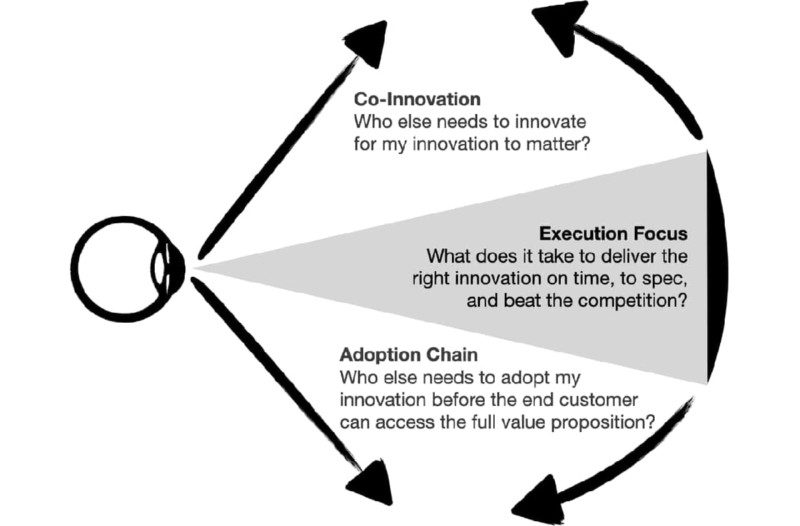
Here is one perspective developed by Ron Adner, author of the bestselling book “The Wide Lense – a new strategy for innovation” called as Wide-lense perspective on innovation strategy.
In most cases, we are focusing on execution, or what does it take to deliver the right innovation on time? What are the specifications that will need to meet? How can we beat the competition? But we focus on this without including two additional vital types of risks that arise within the innovation ecosystem or networks:
- The first one is a co-innovation risk, or who else needs to innovate for my innovation to matter? Your success will depend on the successful commercialization of other innovations.
- The second risk is the adoption chain risk. Before the end customer can access the full innovative product, who else should adopt my innovation?
How to Build Innovation Network
Partners are other companies or individuals that provide the company’s resources required for the network to operate normally.
So, if you want to build an innovation network, here are the questions that you will need to ask and answer:
- What are the possible key partners/stakeholders: individuals, groups, and organizations interested in innovation and can contribute to it?
- What communication channels will we use to communicate and share ideas?
- How will you encourage members to actively participate in the network by sharing their ideas, knowledge, and resources? How will you facilitate collaboration?
- What key resources will we get from partners inside the network? Is it knowledge or competencies? Is it fresh ideas? Or funding?
- What key activities will they need to perform? What will each member inside the network need to do to achieve the network’s goals?
- What types of relationships need to be built with those key partners? How will members communicate? How will they share their achievements? Who will report to whom?
- How can you evaluate and improve the network’s performance and make adjustments to ensure it meets its goals and remains relevant?
- How can you reward the contributions of the individuals, groups, and organizations contributing to the network?
How Partners Validate Each Other Potential Member of the Innovation Network

In many cases, big companies acquire small new startup companies with innovative products, services, processes, or business models. But sometimes, small companies will need help from larger companies with more extensive infrastructures to bring innovation to the market. This is a challenging task for small companies.
So, the partnerships must be validated by checking the existence of mutual benefits, mutual success, co-development or co-innovation, and common customers.
Steps for building partnerships
Here are some steps for building partnerships:
- Define the necessary partnerships. For example, if you need R&D facilities, define a specific need for a partnership related to R&D. If you want help with marketing for your innovation to succeed, define a particular partnership for this purpose. At the end of this step, you will have different areas where you will need different partnership levels.
- List possible benefits for you and your partner. When you know areas where you will need partners, you can start brainstorming different benefits for you and potential partners inside the innovation network.
- Define potential partners for each required partnership. Now, you can start defining potential partners for each area you have identified in the first step of this process. You must develop a list of potential partners for each required partnership.
- Contact potential partners. In the fourth step, you must contact all potential partners to explain your idea and the benefits they will get if they become part of the network.
- Partnership negotiation. It is time to start the negotiation process with all potential partners wanting to join the network. Here you must negotiate critical resources, activities, communication channels, types of relationships, rewards for members, etc.
- Implementation of the agreement. When you agree with all of the partners, the network can start the operational stage.
- Monitor the progress of the partnership. And the last step is to monitor the progress and improve based on the network’s performance.

